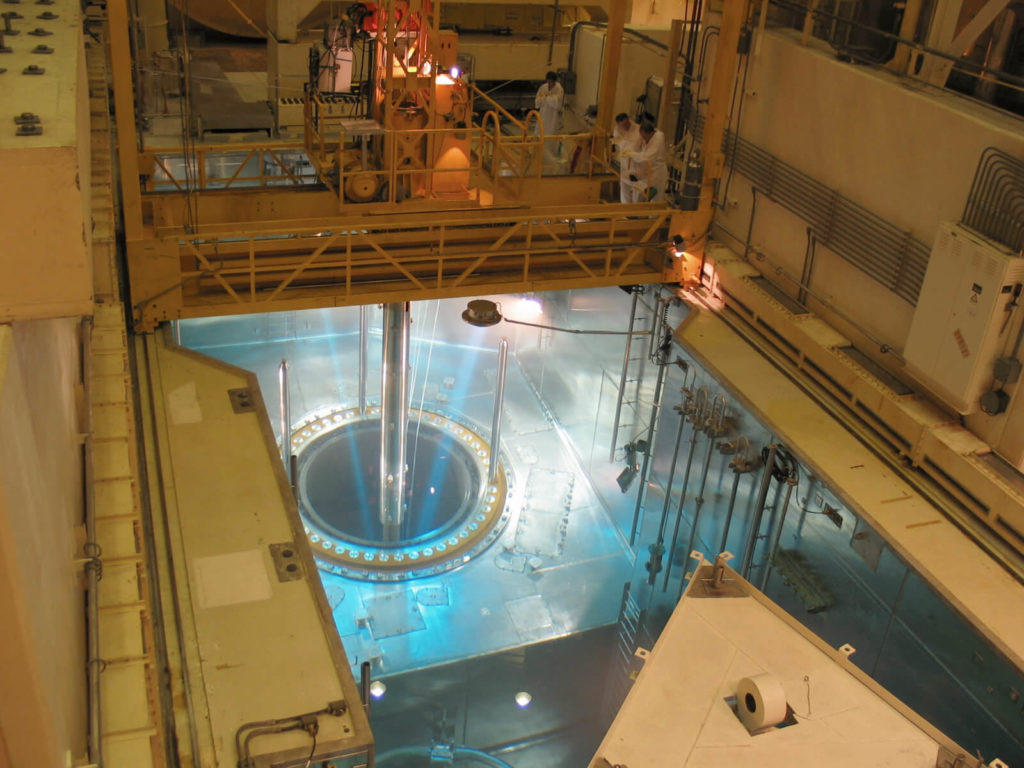Of all residual materials from the operation and decommissioning of the Krško NPP, spent nuclear fuel (SNF) has by far the highest radioactivity concentration. Slovenia and Croatia are jointly responsible for spent nuclear fuel from a single nuclear power plant (the Krško NPP), which is a relatively small amount when compared to other countries with developed nuclear programmes and several nuclear plants. Dividing this miniscule amount of SNF in halves that are then to be disposed of separately in Slovenia and Croatia would undoubtedly drive up the price of SNF disposal for both countries.
During regular outage of the Krško NPP (previously every 12 months, now every 18 months), spent fuel elements are removed from the reactor and replaced. After extraction, the spent fuel elements are stored in a special pool next to the reactor. According to the Krško NPP data for late 2019, the spent fuel pool held 1,320 spent fuel elements from 30 previous fuel cycles, with a total weight of 513 tons.
Table: An overview of the Krško NPP SNF inventory
| Features | 2023. | 2043. |
|---|---|---|
| Number of spent fuel elements | 1.498 | 2.282 |
| Mass (t) | 870 | 1.330 |
| Activity (Bq) | 5,4 x 1020 | 8,2 x 1020 |
The first step of SNF managment outside the nuclear power plant pool should be transfer to dry storage. Based on recent safety assessments conducted with the support of the International Atomic Energy Agency (IAEA), the solution for long-term SNF storage is building a dry storage facility at the Krško NPP site. The construction of the dry storage will begin in 2021, following the environmental impact assessment and after obtaining a building permit. The SNF storage facility will be based on the HI-STORM FW dry storage system by Holtec lnternational. Spent fuel elements are stored in multi-purpose canisters (MPC), which are then inserted into the HI-STORM canister (overpack). Each MPC is capable of containing up to 37 spent fuel elements. SNF should stay in dry storage up to 60 years after the permanent shutdown of the Krško NPP.
The final fate of spent nuclear fuel is still uncertain. The RW, DS and SNF management strategy provides for SNF classification and management as high level radioactive waste in a deep geological repository, but SNF reprocessing is also an option.
SNF disposal after storage is the only option that the two countries can plan independently, without relying on third-country facilities and services, and is therefore a necessary reference option until any potential permanent solution is firmly agreed upon. The financing plan for SNF disposal is therefore based on the assumption that SNF will be disposed in a joint deep geological repository after storage. In the EU, one of the SNF disposal methods is the establishment of a regional/multinational/EU SNF repository. This is advocated by groups in several member states (ERDO, ENSREG).
On 12 January 2021, the Fund for financing the decommissioning of the Krško NPP became a full member of the ERDO Association. The ERDO Association has endorsed a long-term programme of joint activities aimed at identifying specific solutions to the issues of radioactive waste and spent nuclear fuel management and advancing joint projects.
From the technical standpoint, SNF disposal is significantly more complex than RW disposal. There are certain factors that need to be taken into consideration. Due to its high radioactivity, SNF generates substantial quantities of heat and requires cooling over a certain timespan after removal from the reactor. In addition, SNF reprocessing generates a certain amount of high level radioactive waste, which requires special treatment, storage and disposal. The management of SNF is a slow process that requires painstaking research, development projects and long-term programmes. As a result, the disposal of SNF is not a priority for national RW and SNF management programmes, as it can generally be safely stored in special pools or dry storage facilities; however, long-term plans should not be overlooked. Due to the intricacies of ownership and rights over the Krško Nuclear Power Plant, obligations under the Bilateral Agreement, decisions of the Intergovernmental Commission as well as obligations arising from EU regulations, any long-term programmes and plans for the management of Krško NPP SNF and HLW should be coordinated jointly.

